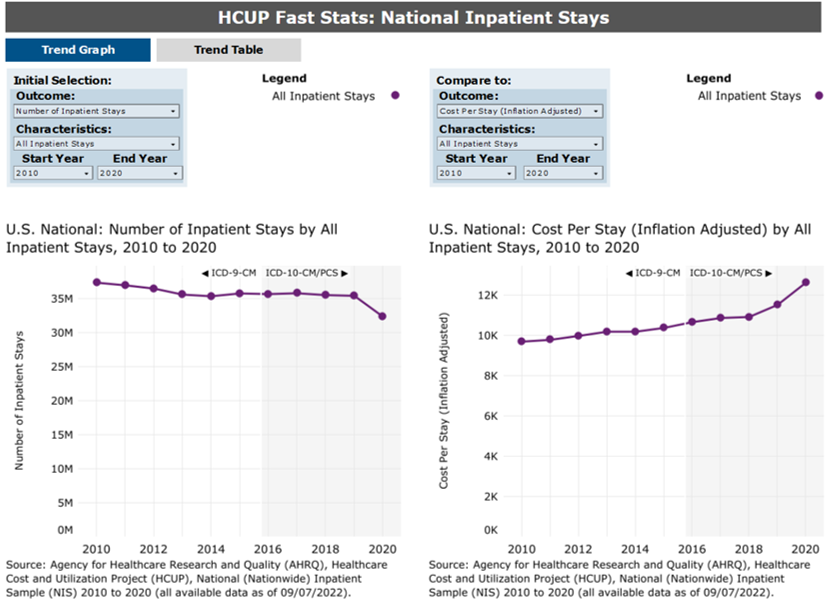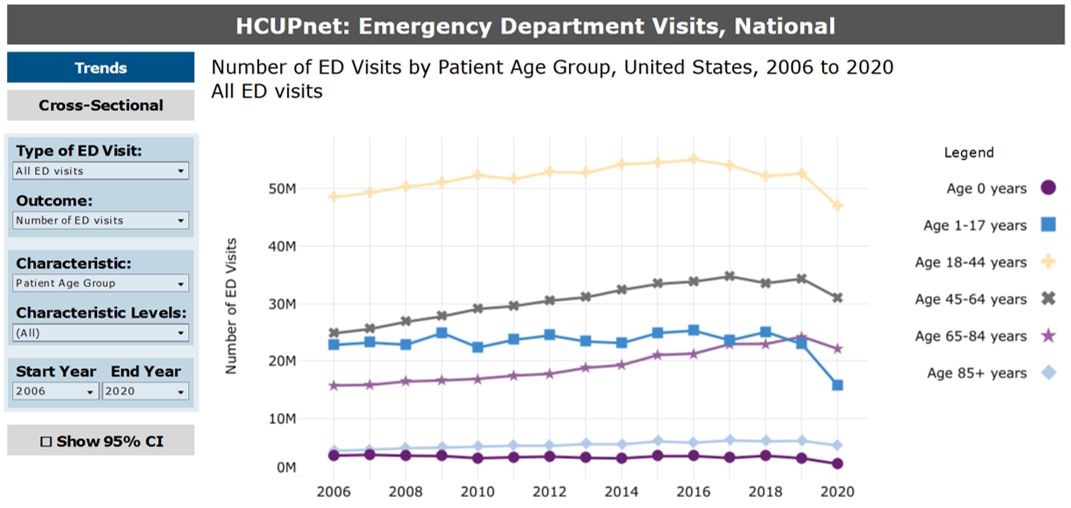

Winter 2022
Issue #73
Contents
News and Announcements: Notable news from HCUP
Databases and Products: New database and product releases
Publication Spotlights: Recent works incorporating HCUP data and tools
HCUP Q&A: Answers to your HCUP questions
HCUP Events: Upcoming HCUP conferences and meetings
Missed the last HCUP e-News? Read it on the HCUP-US website.
Now Available: Chronic Condition Indicator Refined (CCIR) for ICD-10-CM
The Agency for Healthcare Research and Quality (AHRQ) has released the Chronic Condition Indicator Refined (CCIR) for ICD-10-CM (International Classification of Diseases, Tenth Revision, Clinical Modification). The CCIR facilitates health services research by allowing researchers to readily identify a diagnosis as indicating a chronic condition. Version 2023.1 of the CCIR for ICD-10-CM returns to a concept consistent with the ICD-9-CM version of the tool, which distinguishes chronic from nonchronic conditions. All ICD-10-CM diagnosis codes are identified as one of the following three categories:
The CCIR and other Healthcare Cost and Utilization Project (HCUP) software tools can be found on the Research Tools page of the HCUP-US website. More information on the CCIR is provided in the HCUP Q&A section of this newsletter.
HCUP Software Tools for ICD-10-CM/PCS Undergo Fiscal Year 2023 Updates
The HCUP software tools for the International Classification of Diseases, Tenth Revision, Clinical Modification/Procedure Coding System (ICD-10-CM/PCS) are updated annually by Federal fiscal year (FY) to accommodate new or revised ICD-10-CM/PCS codes, as well as to add corrections or modifications based on new clinical guidance for the use of ICD-10-CM/PCS codes. AHRQ has released the following updated HCUP software tools valid for ICD-10-CM/PCS codes through FY 2023:
See the Research Tools page of the HCUP-US website for more information on the changes to each tool.
Additional HCUP 2020 Nationwide Databases Released
AHRQ has released the 2020 Nationwide Ambulatory Surgery Sample (NASS), Nationwide Emergency Department Sample (NEDS), and Nationwide Readmissions Database (NRD). The 2020 National Inpatient Sample (NIS) is also available. The NIS, NASS, NEDS, and NRD are produced as part of HCUP to enable research on healthcare issues and trends that are of interest to policymakers, researchers, administrators, and consumers.
The NASS produces national estimates of in-scope ambulatory surgery encounters in hospital-owned facilities. The NASS contains clinical and resource-use information that is included in a typical hospital-owned facility record, including patient characteristics, clinical diagnostic and surgical procedure codes, disposition of patients, total charges, expected source of payment, and facility characteristics.
The NEDS generates national estimates about emergency department visits across the country, regardless of whether the visit results in admission. One of the most distinctive features of the NEDS is its large sample size, which allows for analysis across hospital types and the study of relatively uncommon disorders and procedures.
The NRD is designed to support various types of analyses of national readmission rates for all patients, regardless of the expected payer for the hospital stay. The NRD includes discharges for patients with and without repeat hospital visits in a year and those who have died in the hospital.
The 2020 NASS, NEDS, and NRD can be purchased through the HCUP Central Distributor. Earlier years are also available. Users are encouraged to sign up for the HCUP Mailing List to be notified of upcoming database releases.
Update to HCUP Online Tutorial Series
The Producing National HCUP Estimates Online Tutorial has been updated and expanded to include instruction and statistical coding on all the HCUP nationwide databases: NIS, KID, NASS, NEDS, and NRD. This tutorial demonstrates how the HCUP nationwide databases can be used to produce national and regional estimates. Users will learn how to select and apply the appropriate discharge or hospital weights to generate national estimates from unweighted counts.
The HCUP Online Tutorials are a set of free, interactive courses to provide HCUP data users with information about HCUP data and tools, as well as training on technical methods for conducting research with HCUP data. The Producing National Estimates Tutorial, along with other helpful HCUP interactive courses, can be found on the HCUP Online Tutorial Series home page.
New Data Featured in HCUP Fast Stats
AHRQ has released new information in HCUP Fast Stats. The National Hospital Utilization and Costs topic has been updated to include national statistics through 2020. This topic presents national statistics on inpatient stays—trends, most common diagnoses, and most common operations—and trends in emergency department visits.

HCUP Fast Stats is now located on the AHRQ Data Tools website at https://datatools.ahrq.gov/. For additional information, please refer to the Fast Stats Frequently Asked Questions (FAQ) page or contact HCUP User Support.
2020 Nationwide and State Data Added to HCUPnet
Statistics from the 2020 NIS, NEDS, and State Emergency Department Databases (SEDD) have been added to HCUPnet, the free, online data query tool based on HCUP data. This data query tool provides healthcare statistics and information for hospital inpatient and emergency department settings, as well as population-based healthcare data on counties. Users can generate tables and graphs on national and regional statistics and trends for community hospitals in the United States.

HCUPnet is now located on the AHRQ Data Tools website at https://datatools.ahrq.gov/. For additional information, please refer to the HCUPnet FAQ page or contact HCUP User Support.
Recently Released: 2021 and Additional 2019-2020 State Databases
Since October 2022, the following State databases have been released:
In addition, the 2020 NASS, NEDS, and NRD have been released. Complete listings of available databases by year can be found in the Database Catalog on the HCUP-US website. Databases can be purchased online through the HCUP Central Distributor, and aggregated national and selected State statistics can be accessed via HCUPnet.
New HCUP Statistical Briefs Posted on HCUP-US
Since October 2022, the following HCUP Statistical Briefs have been released:
To access these and other Statistical Briefs, please visit the HCUP Statistical Briefs page on the HCUP-US website.
New HCUP Methods Series Report Available
Since October 2022, the following Methods Series Report was released:
This HCUP report and others can be found on the HCUP Reports page of the HCUP-US website.
Question: I am eager to use the newly released v2023.1 of the Chronic Condition Indicator Refined (CCIR) for ICD-10-CM, but before I get started, I have a few questions:
Answers:
How is the CCIR for ICD-10-CM different from prior versions of this tool?
In beta version v2021.1 of the Chronic Condition Indicator (CCI) for ICD-10-CM, AHRQ attempted to distinguish acute from chronic conditions. However, further analyses revealed that this distinction is difficult to make. In v2023.1, the tool moves out of beta status as the Chronic Condition Indicator Refined (CCIR) for ICD-10-CM, with the same intent as the ICD-9-CM version of the tool—that is, to identify diagnoses indicative of a chronic condition. Each ICD-10-CM diagnosis was reviewed by a team of clinical experts with a guiding set of rules to designate an individual diagnosis code as chronic, not chronic, or no determination.
What does the value "no determination" mean?
For certain ICD-10-CM diagnosis codes, no determination is made in the identification of a chronic condition. This value includes the following types of ICD-10-CM codes:
Although some factors influencing health status and contact with health services (ICD-10-CM codes starting with Z) may indicate a chronic condition, ICD-10-CM Coding Guidelines indicate that they must be reported with the diagnosis. In those cases, the CCIR would designate the diagnosis as chronic and the Z code as no determination. For example, section C.21.c.3 of the ICD-10-CM Coding Guidelines states that body mass index codes should only be assigned when there is an associated reportable diagnosis such as obesity. The CCIR would designate the obesity diagnosis as chronic and the associated body mass index code as no determination.
For the ICD-10-CM diagnosis codes related to a fracture or complication of a prosthetic, prosthetic device, or other device, implant, or graft, it is unclear from the code description whether such devices are temporary or permanent.
For some of these codes, users may wish to assign a value of chronic or not chronic based on their analytic purpose. The no determination designation enables users to better identify groups of codes for further evaluation.
Can I assume that a value of "not chronic" indicates an acute condition?
It is important to understand that the designation of not chronic is not synonymous with acute. For example, diagnoses indicating pregnancy or a benign neoplasm are not chronic conditions, but they also are not acute conditions requiring immediate short-term treatment.
I am interested in counting the number of chronic conditions on a discharge record. Do you have any guidance on conducting this type of analysis?
We recommend exercising caution when conducting an analysis that counts the number of chronic conditions on a discharge record. It is possible that more than one diagnosis on the hospital record indicates the same type of chronic condition. In some cases, the ICD-10-CM Coding Guidelines require that two related diagnosis codes be reported. For example, during pregnancy, childbirth, or the puerperium, a patient admitted to the hospital for an illness related to HIV should have a principal diagnosis code of O98.7-, Human immunodeficiency [HIV] disease complicating pregnancy, childbirth and the puerperium, and a secondary diagnosis code of B20, Human immunodeficiency virus [HIV] disease. The CCIR value for both codes is chronic, but this does not mean that the patient has two distinct chronic conditions.
For users interested in counting chronic conditions on a record, the CCIR may be used in combination with the Clinical Classifications Software Refined (CCSR) for ICD-10-CM. The CCSR for ICD-10-CM aggregates individual ICD-10-CM diagnosis codes into over 530 clinical categories. The CCSR categories can be used to help identify when multiple diagnosis codes indicate a similar chronic condition. For example, consider a record that includes two diagnoses, both of which are marked as chronic. One diagnosis is mapped to the CCSR category END003 (Diabetes mellitus with complication), and the second diagnosis is mapped to the CCSR category END004 (Diabetes mellitus, type 1). Although two separate CCSR categories are assigned, there is still only one type of chronic condition present (diabetes).
Unfortunately, one cannot assume that if a diagnosis code that maps to a CCSR category is chronic, all diagnosis codes mapped to the same CCSR category are also chronic. For example, the diagnosis code B00.82, Herpes simplex myelitis, indicates a chronic condition and is included in the CCSR category INF008 (Viral infection). Most of the other diagnosis codes included in this CCSR category are not chronic.
There are no upcoming events at this time. Please refer to the HCUP Events Calendar for updates on future activities.
The HCUP e-News is available online on the HCUP-US website and distributed via the HCUP Mailing List.
For more information and questions regarding the HCUP e-News, please email hcup@ahrq.gov